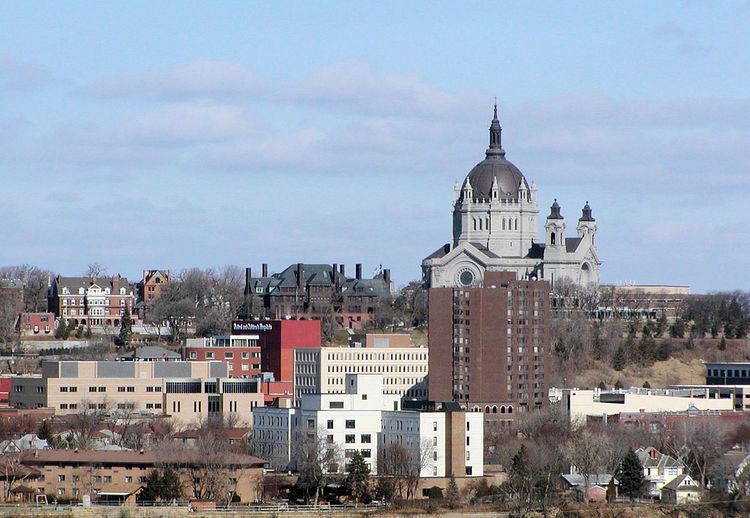Built 1860 NRHP Reference # 76001067 | Architect Multiple Added to NRHP August 13, 1976 | |
 | ||
Location Irregular pattern from Pleasant and Grand Aves. to Holly and Marshall Aves., from Lexington Pkwy. to 4th and Pleasant in St. Paul, Minnesota Architectural style Late 19th and 20th Century Revivals, Late Victorian | ||
Summit Avenue is a street in Saint Paul, Minnesota, United States, known for having a number of historic houses, churches, synagogues, and schools. The street starts just west of downtown Saint Paul and continues four and a half miles west to the Mississippi River where Saint Paul meets Minneapolis. Other cities have similar streets, such as Prairie Avenue in Chicago, Euclid Avenue in Cleveland, and Fifth Avenue in New York City. Summit Avenue is notable for having preserved its historic character and mix of buildings, as compared to these other examples, and it remains a well-preserved example of a Victorian residential boulevard.
Contents
- Map of Summit Ave St Paul MN USA
- History
- Criticisms
- Notable buildings
- National Historic Landmarks
- National Register of Historic Places
- Other notable buildings
- References
Map of Summit Ave, St Paul, MN, USA
Summit Avenue is part of two National Historic Districts and two City of Saint Paul Heritage Preservation Districts. The National Historic Districts are the Historic Hill District, an irregular area roughly bounded by Lexington Avenue, Portland Avenue, Dale Street North, Marshall Avenue, Pleasant Street, and Grand Avenue (exclusive of the area within the Woodland Park Historic District), and the West Summit Avenue Historic District, a narrow area running from Oxford Street South west to the Mississippi River along Summit Avenue. The city districts are Summit Hill, also known as Crocus Hill, a triangular region from Lexington Avenue on the west, Summit Avenue on the north, and the bluffs (just north of Interstate Highway 35E) on the south, and Ramsey Hill, the area bounded by Summit Avenue, Dale Street, Interstate Highway 94, and a line running north from the Cathedral of Saint Paul. Most of the houses in this district are large, distinctive houses built between 1890 and 1920.
Summit Avenue was named one of 10 "great streets" nationally by the American Planning Association in 2008.
History
The history of Summit Avenue dates back to the early 1850s, when Saint Paul was in its infancy. Mansions were starting to appear on top of the hill in the earliest days of the city. An 1859 photograph by Joel Whitney shows six houses on the hill. Edward Duffield Neill owned the first house on Summit Avenue, in a location now occupied by the James J. Hill House. Continuing westward, the photo shows the houses of William and Angelina Noble, Henry F. Masterson, Henry Mower Rice, Henry Neill Paul, and David Stuart. The Stuart house, at 312 Summit Avenue, is the only one of these still standing, making it the oldest remaining house on Summit Avenue and one of the oldest in Saint Paul.
Development was slow during the American Civil War and afterward, but the district began to grow in the 1880s. City water service was provided in 1884, and a cable car line built on Selby Avenue in 1887 provided improved access to downtown. In 1890, the city's first streetcars began operating on Grand Avenue, just south of Summit, and the Hill District became a fashionable place to live.
The district began to decline in the 1930s as many old mansions either turned into rooming-houses or went vacant for many years. The housing stock was not decimated by commercial development pressure, as the bluffs separating the Summit Avenue area from downtown St. Paul made it difficult for downtown to expand into the area. The area began to turn around in the 1960s and 1970s, as young couples discovered that the Victorian homes could be purchased affordably and could be restored over time. Neighborhood associations also formed and helped with preservation efforts. The Hill District is again one of the most fashionable places to live in Saint Paul.
Summit Avenue has the longest line of Victorian style housing in the nation.
Criticisms
Frank Lloyd Wright, noted as "the greatest American architect of all time" by AIA, claimed that Summit Avenue is "the worst collection of architecture in the world." This was in part due to the imposing scale of the buildings, but mainly because Summit Avenue architecture copied design styles from Europe, rather than attempting to find an original American aesthetic. F. Scott Fitzgerald disliked Summit Avenue as well, stating that Summit Avenue is “a mausoleum of American architectural monstrosities.”
Notable buildings
These buildings are listed in numerical address order.
National Historic Landmarks
Three buildings on or near Summit Avenue are National Historic Landmarks (NHLs).
National Register of Historic Places
A number of buildings on Summit Avenue are listed on the National Register of Historic Places (NRHP).
Other notable buildings
Other buildings include:
